-
-
FeaturesคุณสมบัติPenyelesaianRecursosFiturCaracterísticas精选功能功能特點المزايا
-
Solutionsโซลูชั่นPenyelesaianSoluçõesSolusiSoluciones解决方案解決方案الحلول
-
IntegrationsการผสานรวมIntegrasiIntegraçõesIntegrationsIntegraciones集成整合服務دمج مع تطبيقات أخرى
-
Affiliate/Partnersพันธมิตร/พันธมิตรทรัพยากรAfiliasi/Rakan KongsiAfiliados/ParceirosAfiliasi/MitraAfiliados/Partners联盟/合作伙伴聯盟/合作夥伴شريك
-
ResourcesจองการสาธิตSumberRecursosSumber dayaRecursosالموارد資源中心

Everything You Need to Know About WhatsApp Newsletters in 2025
Do you know Lenny Rachitsky Lenny’s Newsletter makes $150,000 at least. And that’s the minimum implied figure as Substack doesn’t disclose the number of followers of its most followed newsletter. So, considering this factor, its income range would be somewhere around $150,000 – $14,999,850. And that’s massive, right? This range truly showcases the earning potential of a newsletter.
But usually, newsletters are distributed through emails. Which, in my opinion, does more harm than good. It’s because emails have an open rate of just 21.33%, which isn’t an encouraging number, especially if you’ve just started out with your newsletter and are building your audience.
But, email is not the only option. There’s a medium that has more than 4X the open rate of emails?
Yes, I am talking about WhatsApp. With a 98% open rate, WhatsApp is a medium on which I feel every newsletter should be on.
So, what exactly is a WhatsApp newsletter and how to get started with it? In this blog, we’ll answer this question along with diving deep into its benefits, best practices, and use cases. But first, let’s have a look at what exactly a WhatsApp Newsletter is.
What Is a WhatsApp Newsletter
WhatsApp newsletter is a bulk message that you can send to your subscribers to promote and share information about your products and services. These are similar to email newsletters with the only difference being that they are sent via WhatsApp to the subscribers who have opted-in to receive them.
7 Benefits of WhatsApp Newsletter
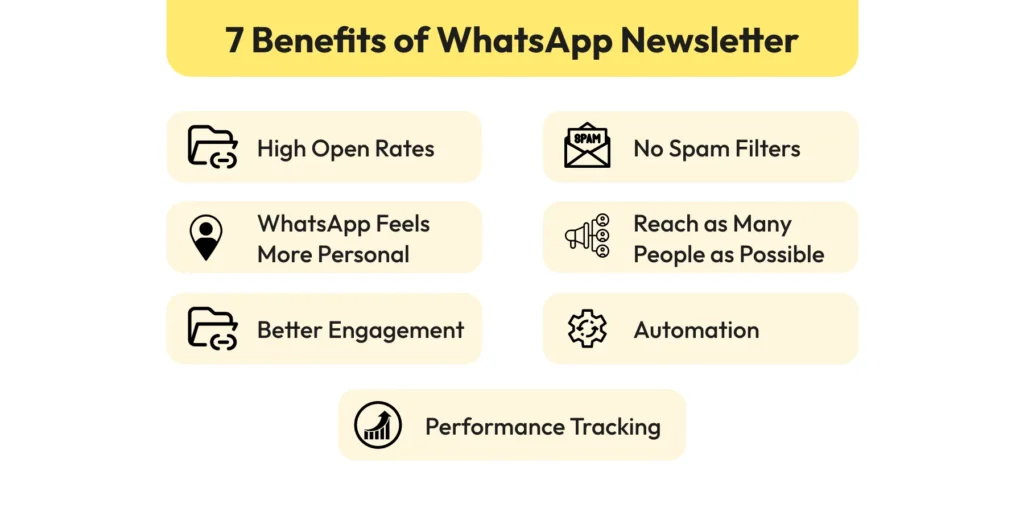
1. High Open Rates
The purpose of a newsletter is to engage with your audience and build trust. But what if your audience doesn’t even open them? Yes, as discussed earlier, that’s exactly what happens with Emails that have a disappointing open rate of only 21.33%.
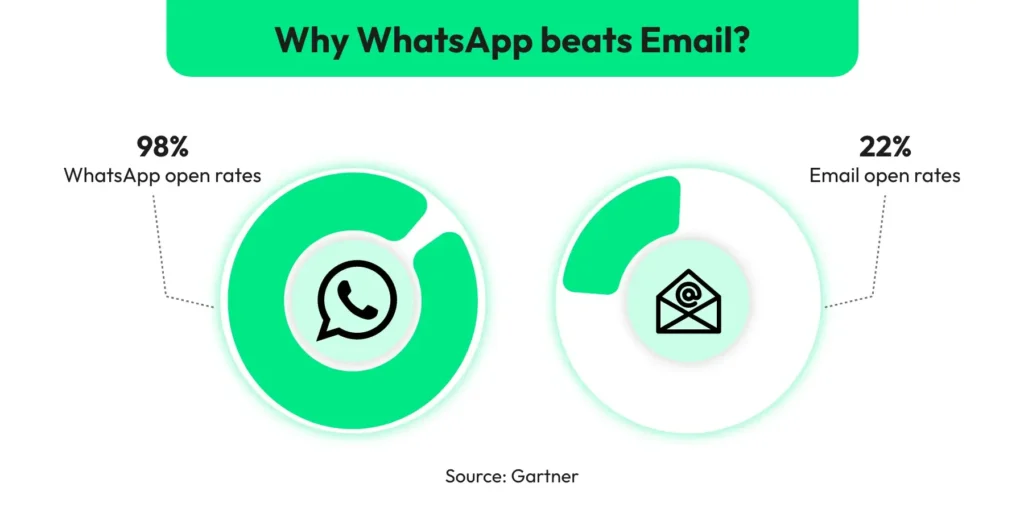
On the other side, WhatsApp boasts an impressive open rate of 98% (that’s almost 4X of the email). So, clearly, WhatsApp wins this battle single handedly. So, next time when you send your newsletter, decide if you want to go to a medium with a 21% open rate or a 98% open rate.
2. Reach as Many People as Possible
As someone who owns a newsletter, I am sure the primary goal is to reach as many people as possible. So, wouldn’t it make sense to choose a medium that has the best reach? When it comes to user penetration, WhatsApp triumphs here too. With over 2.8 billion users worldwide, WhatsApp gives you the best reach for your newsletters.
But, it’s important to note that WhatsApp is not equally popular in all corners of the world. To check the total WhatsApp users in your region, have a look here.
3. WhatsApp Feels More Personal
WhatsApp is mainly used for casual communication which makes the medium much more personal than emails. Businesses can take advantage of this via WhatsApp newsletters to create a stronger emotional bond with their customers. This bond can help businesses influence consumers' buying behaviour.
4. No Spam Filters, No Restrictions
Apart from high open rates, another distinct advantage your WhatsApp newsletter offers is that it guarantees to reach your target audience without encountering spam filters or any other restrictions.
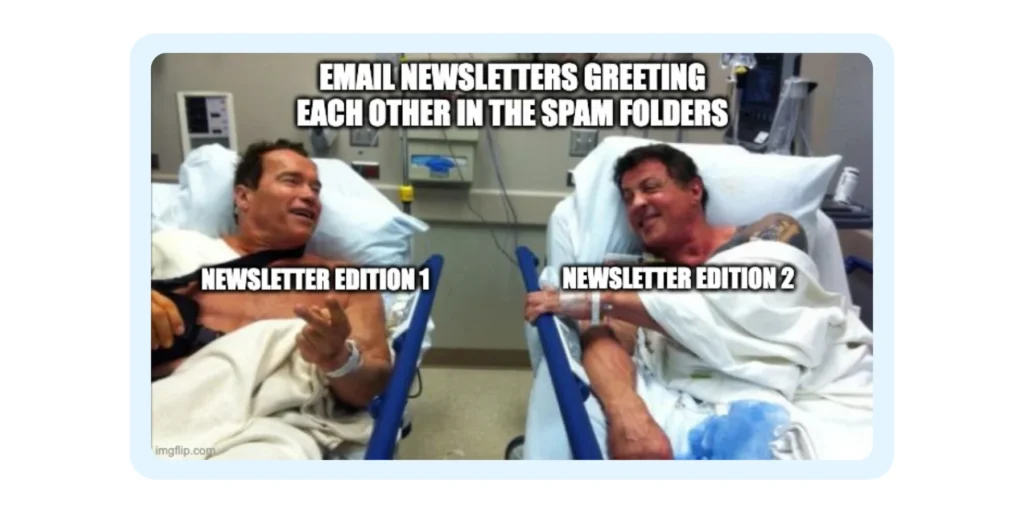
Unlike email newsletters, which must navigate multiple obstacles to reach your audience, WhatsApp newsletters enjoy direct access to your audience.
5. Better Engagement
A successful newsletter is the one that engages the audience. But traditional emails, and newsletters end up being a one-way conversation. WhatsApp being a chat platform enables your newsletters to be more interactive. You can add elements like reply buttons and lists to make your WhatsApp newsletter more engaging and interactive.
6. Automation
Using the automation features of WhatsApp, you can achieve the desired scale and efficiency for sending out your WhatsApp newsletters. To leverage automation, you need help from WhatsApp Business API service providers like Wati.
With Wati, you can:
- Schedule newsletters at specific times and dates, ensuring your audience receives them consistently without manual effort.
- Broadcast your WhatsApp newsletters to targeted groups using pre-defined broadcast lists based on subscriber preferences or demographics.
- Personalize newsletters with information like names or birthdays, fostering a more personal connection.
- Include buttons or quick replies within the newsletter, allowing subscribers to easily respond to polls, quizzes, or questions, boosting engagement.
- Set up automated messages to remind non-responders to open the newsletter or answer any questions, increasing engagement.
7. Performance Tracking
With WhatsApp newsletters, you get the opportunity to track performance by getting access to data like:
- Open rates
- Click-through rates
Analysing these data can help you refine your WhatsApp newsletter strategy.
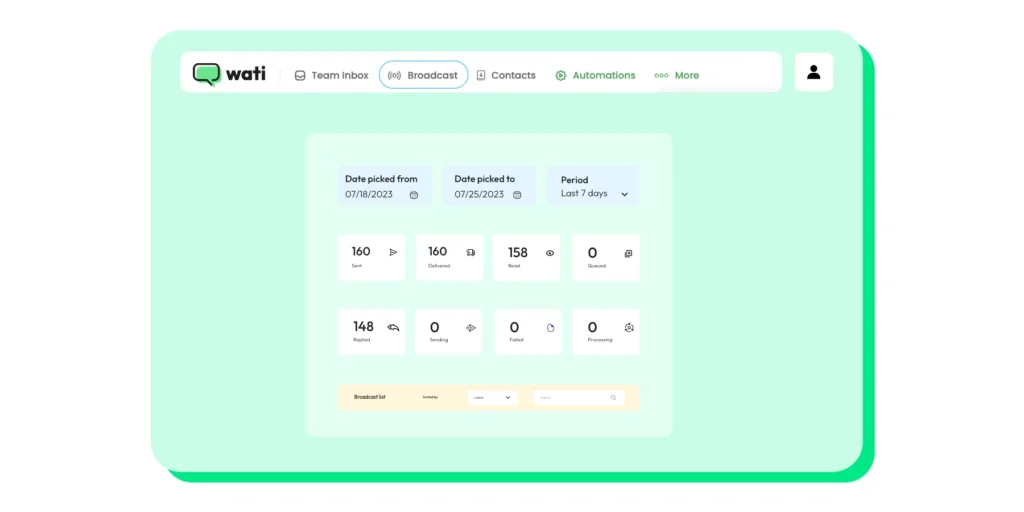
WhatsApp Newsletter: Top 5 Use Cases
1. Customer Updates
Customer updates through WhatsApp newsletters are an effective way for businesses to keep their customers informed about various aspects of their products, services, and operations.
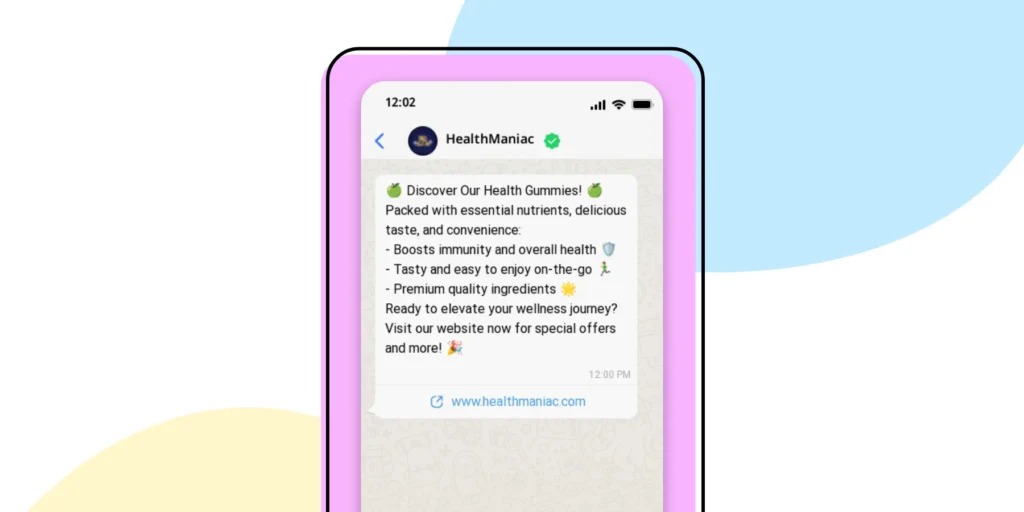
Here's how businesses can leverage WhatsApp newsletters for customer updates:
- Product Launches & Updates
- Service Changes & Enhancements
- Promotions
- Policy Changes & Terms of Service Updates
2. Event Reminders
Event reminders via WhatsApp newsletters offer a convenient and effective way for organisations to keep attendees informed about upcoming events, conferences, webinars, workshops, and more.

Here's how event reminders can be expanded upon through WhatsApp newsletters:
- Pre-Event Information
- Schedule Updates
- Speaker Profiles and Highlights
- Registration and Ticketing Updates
- Exclusive Content Sneak Peeks
- Post-event Follow-up
3. Content Distribution
WhatsApp newsletters offer a direct and engaging way for publishers, bloggers, content creators, and businesses to reach their audience with valuable and relevant content.
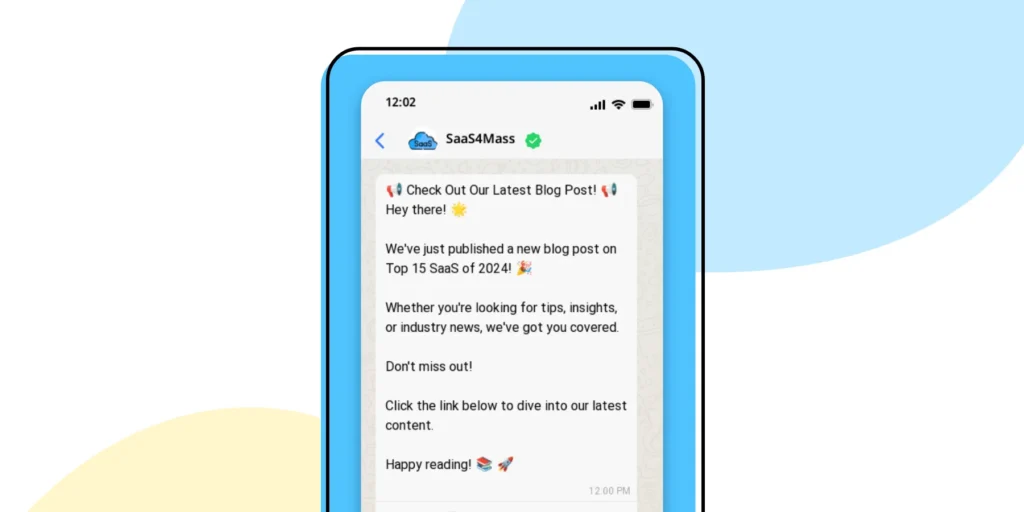
Here are the types of content that one can distribute via WhatsApp newsletters:
- New Blog Posts
- YouTube Videos
- Podcast Episodes
- Infographics
- Webinar Invitations
- Ebooks & Whitepapers
4. Exclusive Offers
Offering exclusive offers and deals via WhatsApp newsletters provides businesses with a powerful tool to engage with their audience, drive sales, and enhance customer loyalty.

Below are the types of offers you can send through WhatsApp newsletters:
- Limited-time Offers
- Flash Sales and Daily Deals
- Early Access to Sales and Promotions
- Rewards and Loyalty Programs
- Referral and Shareable Offers
5. Survey & Feedback
Surveys and feedback sent via WhatsApp newsletters enable businesses to gather valuable insights and improve customer experiences efficiently.
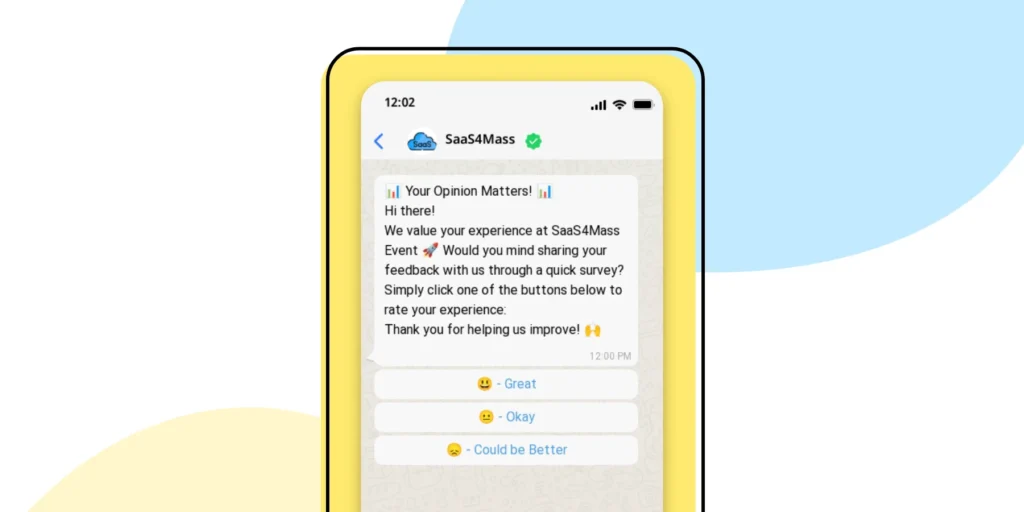
Types of feedback and surveys that can be sent include:
- Customer satisfaction surveys
- Product feedback and reviews
- Market research surveys
- Event and workshop feedback
- Website and user experience feedback
- Employee engagement surveys
- Brand perception and reputation surveys
- Net Promoter Score (NPS) surveys
- Product development and innovation surveys
- Post-purchase feedback and support
WhatsApp Newsletter: 7 Best Practices

1. Clear Value Proposition
Make it clear to your subscribers what they have signed up for. Irrespective of what kind of content you distribute in your WhatsApp newsletter, establishing transparency is always a good practice. Promising the moon and stars and then failing at the delivery could lead to an instant failure of your newsletter.
2. Make Your Content Concise
If clarity is important then so is conciseness. In the age of micro-content and decreasing attention spans, ensure that you get the hold of your audience’s attention as quickly as possible. Ensure that you cut to the chase and showcase immediately how the customer could benefit from the newsletter.
3. Schedule Your Newsletter Effectively
Establishing a consistent schedule for your WhatsApp newsletter is key to its success. Depending on your business and use case, you can decide to have a weekly, bi-weekly, or monthly newsletter. No matter the frequency, remember that the main goal of your newsletter should be to keep your audience hooked in such a way that they are always looking forward to the next update.
Apart from this, you can follow the below best practices related to the timing and scheduling of your newsletter.
- Avoid sending WhatsApp messages too frequently to prevent user opt-outs.
- Maintain a balanced interval between messages to keep subscribers engaged.
- Limit newsletters to once a week to avoid overwhelming the subscribers.
- Adjust timing based on the content of your newsletter; for promotional reminders, consider shorter intervals, while informational newsletters can have longer intervals.
4. Identify and Reuse High-performing Template
Creating a new WhatsApp template every time you send a newsletter is time-consuming. A smarter approach would be to identify and reuse the ones that yield the best results. Over time, it becomes evident which templates are most effective for your audience. Also, using pre-approved templates eliminates the risk of non-approval from Meta that a new template may encounter.
5. Encourage Interaction
Remember your WhatsApp newsletters’s aim is to keep your audiences engaged. To drive engagement, you need to encourage interactions through actions like:
- Asking questions
- Soliciting feedback
- Creating polls
6. Add Emojis 🤩
Although WhatsApp newsletters are supposed to be informative, it doesn’t mean they have to be boring. To make your newsletter visually appealing, you can add elements like:
- Images
- Videos
- Emojis
- Gifs
7. Give Your Subscribers a Chance to Unsubscribe
So, how is allowing your subscribers to unsubscribe a best practice, you ask?
Here’s why.
- First, this option prevents users from reporting you as spam.
- Second, this option shows your audience that you value their personal space and are not here to shove your content without their permission.
- Third, the opt-out option allows you to request feedback, helping you to know the exact reason why they chose to unsubscribe. This feedback can help you make amends and decrease the churn.
WhatsApp Newsletter Success Story - Finance With Sharan
Sharan Hegde is one of India’s top finfluencer with over 3.9 Million followers across social media channels. He has created a community for finance enthusiasts called The 1% Club.
Within this community, he also runs a WhatsApp Newsletter named Finance With Sharan where he shares one comic per day on topics like personal finance, financial news, and the latest finance trends.
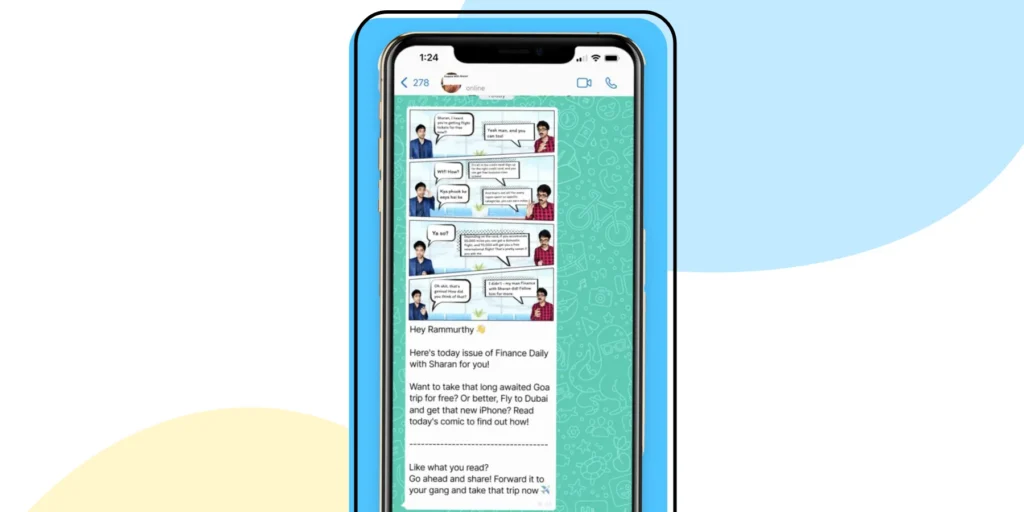
He also conducts interactive quizzes that have monthly winners.
This newsletter comes with an annual subscription of ₹ 365.
Below is a LinkedIn comment where Sharan expresses his views on WhatsApp Newsletters.

How to Create a WhatsApp Newsletter via Wati
1. Get WhatsApp Business API
The first step in creating your WhatsApp newsletter is to get the WhatsApp Business API. And for that, you need to follow the below steps:
- Sign up for a WhatsApp Business Account
- Apply for API Access from your WhatsApp Business Account dashboard
- Choose a reliable WhatsApp API Provider like Wati to enable WhatsApp newsletter feature
- Setup Your Wati Account
2. Collect Opt-ins From Customers
To get your WhatsApp newsletters started, you need subscribers. To do that, you first need to collect WhatsApp opt-ins. There are several ways to collect WhatsApp Opt-ins. First, you can start from your homepage, which is the best place to drive opt-ins. There are a couple of ways you can employ via your homepage to enable opt-in for your newsletters.
a. Pop Ups
First, you can use popups. Popups are a great way to grab visitors’ attention. Once you have their attention, the chances of them subscribing to your newsletter increase significantly.
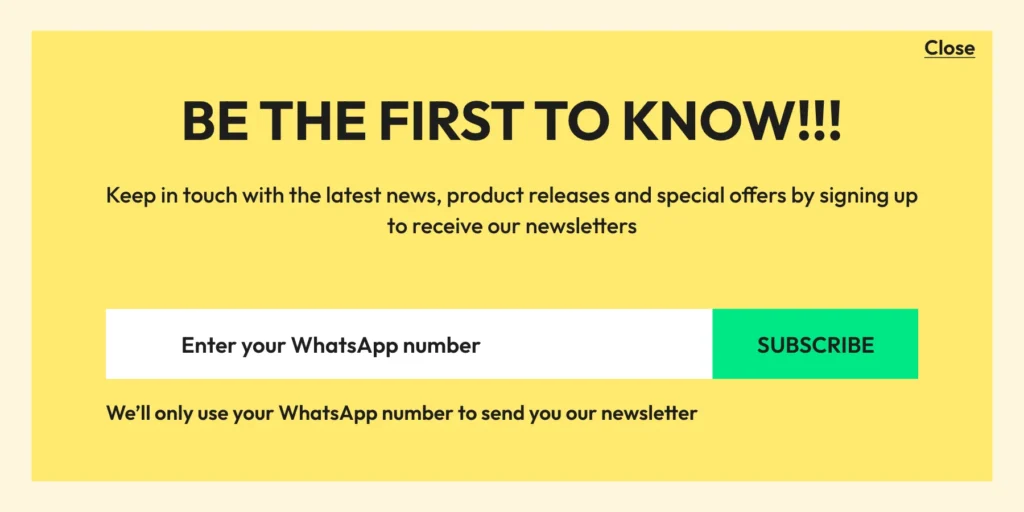
b. QR Code
If you’re not a fan of using popups or are restricted due to a technical or resource limitation issue, you can try using a QR code.

QR codes are ubiquitous and users are habituated to using them. Even adding them is easy. All you need to do is embed a QR code on your homepage that takes your visitors straight to your WhatsApp conversation with your brand.
To generate a QR code for free you can use Wati’s free WhatsApp QR Code Generator.
c. Landing Page
If you can and want to put more effort and money into your newsletter opt-ins, the best option is to have a dedicated landing page for it. A separate landing page gives you enough real-estate to provide important information that can persuade the visitor to end up becoming your subscriber.
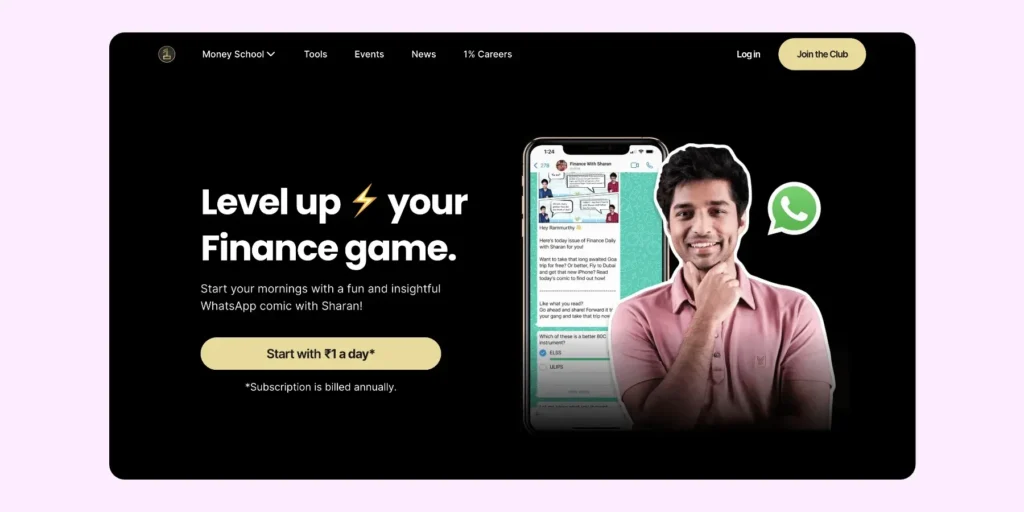
You can use the magic of design and copywriting to pitch your WhatsApp newsletter to your prospects the way you want.
d. Create CTWA (Click to WhatsApp Ads)
If you want to leverage performance marketing options to drive opt-ins, you can give CTWA a shot. CTWA acts as an entry point to start a conversation (in this case an entry point for a newsletter subscription).
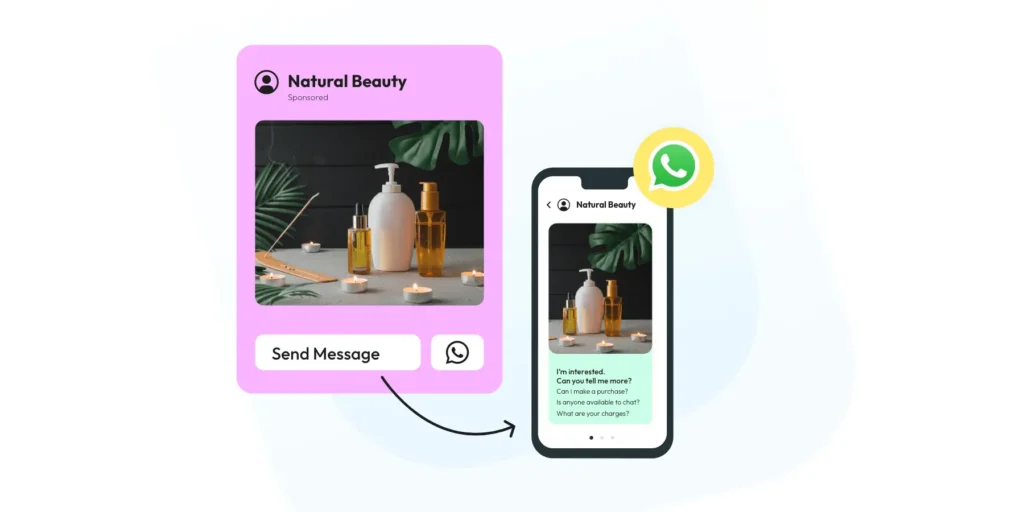
Apart from the convenience they offer to your prospect to subscribe to your newsletter, it also enables you to know through which channels they came to you and why.
3. Setup WhatsApp Newsletter on Wati
First, click on “New Broadcast” and give your WhatsApp Newsletter a name.
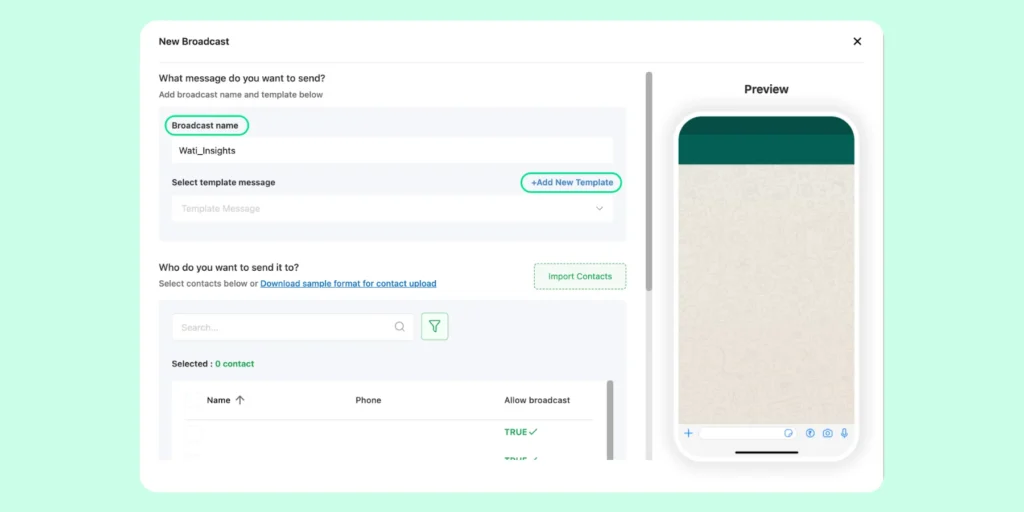
Next, to create a template for your first newsletter edition, click on “+Add New Template” button.
a. Create a Newsletter Template (Submit & Approval)
To create a new template message, fill in details like:
- Template Name
- Category
- Language
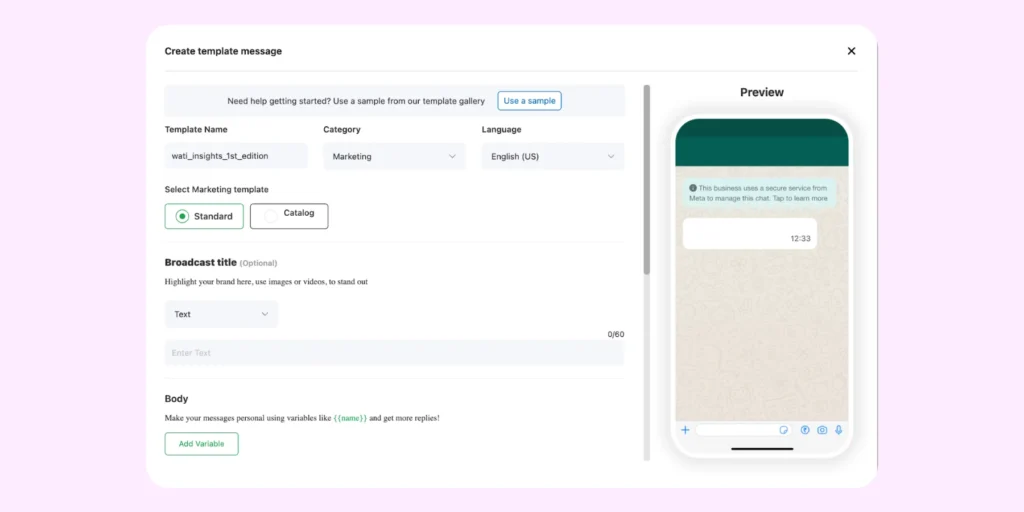
Next, for the “Header”, you can decide to keep it in either text or choose media like photos, videos, or a document. Here, we have kept it media and uploaded an image.
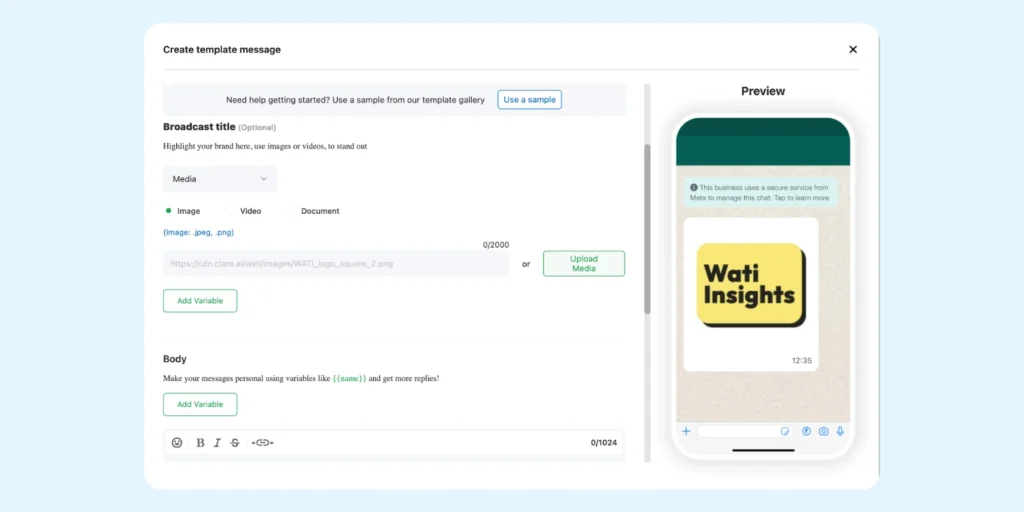
Next, in the “Body” section, add the body of your newsletter. You can also add the variable to make your newsletter more personalised.
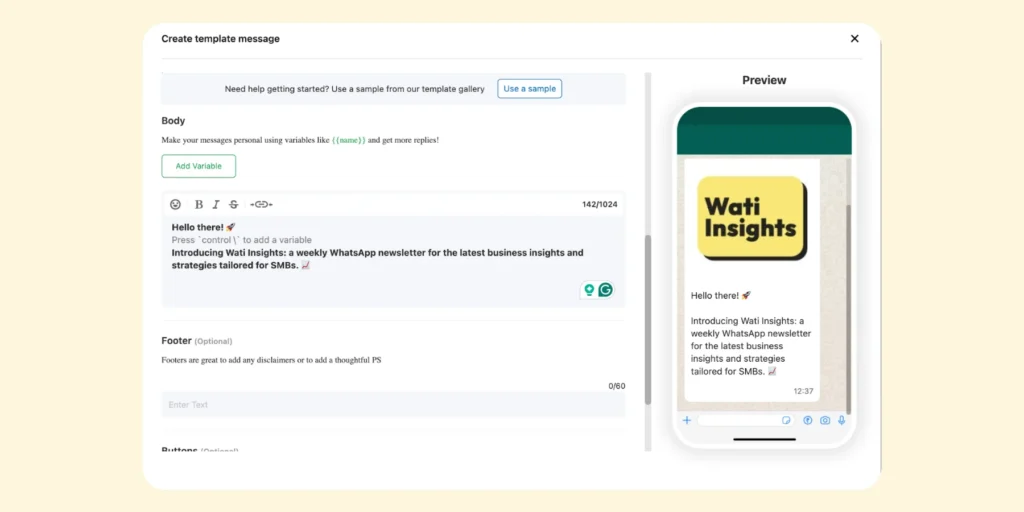
You can also add a footer to your WhatsApp newsletter by adding the content in the “Footer” section.
And lastly, you can add up to 3 buttons to your newsletter. You can add CTAs or a reply option through the button option. Here, we have added one CTA button which redirects users to the Wati’s homepage.

Once everything is done, save and submit your template for approval. Sit back and wait as it generally takes 30 minutes to 48 hours as per WhatsApp's service level.

b. Select / Create Contact List
Next, you have to select the contacts of your newsletter subscribers. Wati allows you to upload a CSV file of the contacts of your subscribers directly into the Wati platform. For this, select the “Import Contacts” option and upload the CSV file of your subscribers’ contacts.
Alternatively, you can also add the contacts from the “Contacts” tab. To see how to do this, watch this video 👇
c. Schedule Newsletter for the Broadcast
Once you complete all the above steps, lastly decide when you want to send the newsletter. Here, you can either send it instantly or schedule it for later.

Conclusion
WhatsApp newsletters offer a powerful alternative to traditional email distribution, boasting high open rates, personal engagement, and direct access to subscribers. With effective strategies and tools like Wati, businesses can leverage WhatsApp to enhance audience reach and engagement.
By prioritizing clear value propositions and concise content, while encouraging interaction, businesses can create impactful campaigns that drive actionable results and foster meaningful connections with their audience. So, what are you waiting for? Start your free trial and create a WhatsApp newsletter with Wati today. For any queries, you can also schedule a demo or contact us.
Frequently Asked Questions
1. Why are WhatsApp newsletters important for businesses?
WhatsApp newsletters are a powerful tool for businesses because WhatsApp is the most popular messaging app in the world with over 2.8 billion active users. WhatsApp users spend a lot of time on the app, and messages are read within five minutes of being sent, making it an effective marketing channel.
What are some tips for creating WhatsApp newsletters?
When creating WhatsApp newsletters, it is important to understand the audience, keep messages short, show the brand's personality, encourage interaction, define a goal and pick a call-to-action, add media and emoji, personalize the content, and give subscribers the option to opt out.
What are messaging templates and flowbots?
Messaging templates are required to send outbound messages after the 24-hour rule, and businesses can use flowbots to create interactive message flows.
Are WhatsApp newsletters a future marketing trend?
Yes, WhatsApp newsletters are a future marketing trend, and businesses should consider using WhatsApp as a marketing channel to reach their audience.
What are the advantages of WhatsApp newsletters compared to email newsletters?
WhatsApp newsletters have a higher open rate (98%) compared to email newsletters (20%). They also have a higher response rate and can include various multimedia content.
Latest Comments